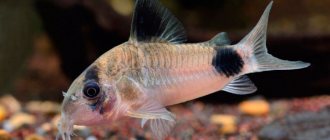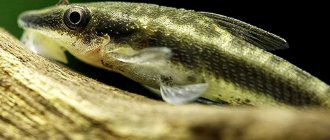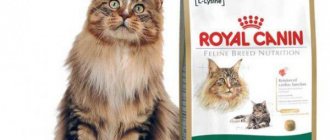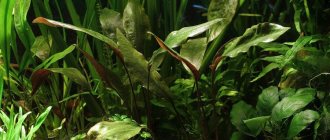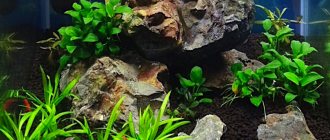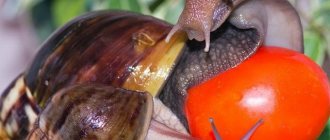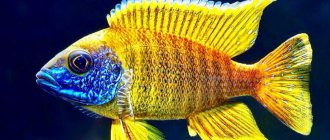The catfish received a scientific description in 1900, the fish was discovered by researcher George Albert Boulenger in the river systems of West and Central Africa in the territory of modern Senegal, Chad, and Gambia.
Requirements and conditions:
- Aquarium volume - from 250 l.
- Temperature - 22–26°C
- pH value – 6.5 – 7.8
- Water hardness - soft to medium hard (2–15 dH)
- Substrate type - any
- Lighting - moderate
- Brackish water - no
- Water movement - moderate
Fish parameters:
- Size - up to 30 cm.
- Food - any, mostly meat
- Life expectancy - 20 years
Homeland and external characteristics
The speckled catfish is native to South America. It lives in the riverbeds of Brazil, Argentina, and Uruguay. For scientists, this species of fish was discovered in 1830; the features of appearance and habitat were described by Charles Darwin. The first successful breeding took place in 1876 and took place in Paris.
In their natural environment, fish prefer shallow water, places filled with plants and algae. During the day they usually live in the thick of vegetation, and at night they swim out to search for food - worms, insects and crustaceans.
Upon closer inspection, you can see the “armor” of the Corydoras.
The speckled catfish has a convex back. The body is covered with a shell, which is formed by bone plates on its sides. The mouth is located below and has whiskers that allow it to find food for itself. The fin on the back is quite high, and like the pectoral fins, it has sharp spines. There are also small spikes under the eyes that serve a protective function, preventing large fish from eating it. The body color has a grayish-olive tint with dark patches. The abdomen is beige-pinkish in color, slightly with a golden tint. Albinos are also found - representatives with a white body and red eyes. Males reach a length of up to 6 cm, females – up to 7 cm.
A special feature of the speckled catfish is its ability to make sounds using its pectoral fins. You can hear this during the spawning period or if young fish are frightened.
Reproduction
In nature, catfish spawning begins during the rainy season. At this time, fish go to the wetlands of the forest and give birth to offspring. However, in aquarium conditions it is difficult to achieve successful reproduction without the use of hormonal injections. The drug is administered only once. After 12 hours, the fish are completely ready to spawn. During this time, the females' abdomen enlarges.
In a separate aquarium, a constant temperature of 25 degrees, hardness of 10 and acidity of 7 pH are set. A pair or a male and two females are transplanted. Every few days, half the volume of water is replaced. When the temperature drops a few degrees, the fish will begin to spawn. The male finds a suitable surface for spawning and cleans it thoroughly. The female then lays eggs in her pelvic fins, swims close to the male so that he fertilizes them, and only then lays the clutch. After this, the producers can be removed, or the male can be left, after covering the eggs with a net to protect them from being eaten.
Those eggs that have not been fertilized turn white and die after a few hours. They need to be removed from the aquarium.
After 5-7 days, the larvae hatch from the eggs. When they empty their yolk sacs and begin to swim on their own in search of food, the male can be removed. Babies need to be fed at least 4-5 times a day. Daphnia, nematode, and artemia are suitable as starter food.
Care and maintenance
| Volume of water per individual | Water temperature | Acidity | Rigidity |
| 10-12 l | From 22 to 24ºС | pH 6.0-7.0 | up to 10 dGH |
Keeping the speckled corydoras catfish at home will not be difficult. In the aquarium, it is imperative to provide for the presence of various snags, grottoes, and stones, among which the fish could hide. Sand or small pebbles are good for soil. Large, sharp stones can damage the antennae when attempting to forage.
It is recommended to keep several individuals in the aquarium at once - from 5 fish.
These fish representatives prefer clean water, so care must be taken to ensure good water filtration and aeration. Every week you need to change at least 20% of the water in the aquarium. General cleaning is required at least once a month, including cleaning the soil, equipment, and decor. Lighting should be moderate and diffused.
Catfish are able to breathe not only with the help of gills, but also to capture air with their mouths, rising to the surface of the water, the so-called intestinal respiration. If this happens frequently, it means there is not enough oxygen in the water. Purchasing a filter that will deliver oxygen to the water will not be superfluous.
Too high a water temperature of over 25ºC will be uncomfortable for fish, so in summer it is worth cooling the water by lowering its temperature.
It is necessary to avoid sudden changes in water parameters, including increases in its acidity, changes in temperature, and nitrate concentrations. Severe deviations in indicators can cause diseases in speckled catfish.
In addition to stones and other shelters, the aquarium can be equipped with various plants, both live and artificial. This will create additional darkening, which representatives of this species of fish love so much.
In the aquarium it is quite active, but can spend a long time in a motionless state in order to obtain food.
One of the few nuances of feeding Corydoras is the position of the mouth. Speckled catfish can only eat food that is on the bottom.
Feeding is done with special mixtures sold in pet stores. The mixtures include plant components, bloodworms, tubifex, and minced seafood. It should be taken into account that raped catfish eat food only from the bottom , so it should be in the form of granules or tablets that will sink down and not float on the surface. It is necessary to feed in the morning and evening, since catfish are active at night, as well as during the day.
Breeding and lifespan
Like most other fish, males are brighter in color than females. Moreover, females are slightly larger in size than their partners. Therefore, even a novice aquarist will not have difficulty distinguishing a male from a female.
To breed shellfish at home, you will need to place one female and several males (two or three are enough) in a separate aquarium. The water in the container must be fresh and contain a large amount of dissolved oxygen, so you will need to install an aerator. For successful mating, it is necessary to reduce the water temperature by 2-3 degrees. It is precisely these conditions that imitate natural conditions: catfish reproduce during the rainy season.
During this period, it is recommended to feed the fish with live food, which is rich in protein. The best option for shellfish would be brine shrimp, bloodworms or tubifex.
The process of reproduction in Corydoras itself is interesting. When the female is ready to mate, her abdomen turns red. The fish become more active, which is manifested in the mating dance. At the same time, the partner begins to “tickle” the fish. Then the male releases seminal fluid, and the female swallows it.
Reproduction in these fish has a number of interesting nuances
After the female lays eggs on any surface (leaves of aquatic plants, stones, filter or glass), she inseminates the eggs herself. This process can take up to one hour. Corydoras can lay from 200 to 400 yellow eggs. After spawning, it is recommended to remove the fish so that they do not eat their offspring.
Within a week, the eggs hatch into fry, which need to be fed with ciliates. Artemia or nauplius are suitable as food for young animals. Within six months, the fish grow by 6 cm (about one per month). If you create all the conditions for the life of Corydoratus in the aquarium, the fish will live up to 8 years.
Compatibility with other aquarium inhabitants
Speckled corydoras are very peaceful fish and are compatible with almost any species, except large predatory representatives that can swallow them.
Compatibility table for Corydoras with other fish.
They get along well with neons, tetras, barbs, zebrafish, angelfish, livebearers, incl. guppy When fish of different species are adjacent, it is necessary to remember that corydoras prefer cool water , so you should not put them in the same aquarium with heat-loving individuals.
Diseases
Catfish are susceptible to bacterial and fungal diseases. The reasons for their appearance may be:
- sudden changes in water temperature in the aquarium;
- the presence of salt in the water, which is poison for them;
- a high concentration of nitrates, which leads to the death of the antennae, which is equivalent to the death of the individual.
When a disease occurs, the behavior of the fish changes - it becomes inactive and lethargic, refuses to eat, and a white coating may appear. If such signs are observed, it is necessary to immediately isolate the catfish in a separate container and begin treatment with medications and vitamins.
Kinds
There are many types of synodontis that have similar features and their own characteristics. Let's look at the most popular ones:
Changeling catfish
Under natural conditions, the skinwalker lives in the waters of the Congo River. It spends most of its time swimming belly up. Body color is neutral beige. There are dark streaks and spots all over the body. The belly is darker than the back. The fins are sharp and prickly, which can be noticed if you try to catch a catfish with a net. Synodontis changeling can not only tear the mesh, but also puncture the finger;
Many-spotted (or cuckoo)
It has a light yellow color with small dark spots. The fins and tail are black with a white edge. Abdomen without punctures. Grows up to 12 cm in length. The catfish acquired its second name due to its non-standard method of reproduction. The female that lays eggs swims past the spawning cichlids (or other fish), throws her eggs at them, and the cichlids, without noticing the substitution, take care of their own and others’ eggs;
Veiled (veil-like)
The largest of all the species presented. In aquarium conditions it can grow up to 30 cm. It has a powerful massive body and a high dorsal fin. Body color is brown, with a black dot. It also prefers to swim belly up almost all the time. Has an uncontrollable appetite. One individual needs an aquarium of at least 100 liters;
Star (or angel)
It got its name because of its unusual and attractive color. It has a brown color with white or orange small dots. It is distinguished by its considerable size, it can grow up to 25 cm. Since Synodontis Dalmatian is a schooling fish, an aquarium of at least 150 liters will be required;
Reproduction of individuals
Reproduction of speckled corydoras sometimes happens in the aquarium itself, but it is preferable to place several individuals in a separate container for this. The aquarium for spawning should be no less than 15-20 liters of water, and there should be driftwood, stones and low-growing plants at the bottom. Usually one female and several males are placed there. You can distinguish a female from a male by the larger size of the female and her rounded abdomen; the males have a larger dorsal fin than the female and a sharper shape. Males are much brighter in color.
External differences between a male and a female Corydoras.
A few days before the planned breeding, individuals of different sexes should be separated from each other and fed intensively. The female's readiness to spawn is indicated by her reddened abdomen. After this, the fish are placed in a common container, this is done in the evening, a little cool water is added, and spawning begins with the first rays of the sun.
A decrease in water temperature in a container is associated by fish with the onset of rains in natural conditions and stimulates the onset of spawning.
Reproduction occurs as follows. The female swallows milk and lays eggs in the ventral fin area. Then she finds a secluded place where she attaches the eggs to a place lubricated with milk. The fertility of female corydoras is quite high, reaching 200-250 eggs. After spawning is completed, females and males are removed from the aquarium, otherwise they may destroy the eggs.
Newborn speckled catfish fry do not immediately become like their parents.
The eggs develop within 5 days. At this time, the water temperature in the aquarium should be higher than usual - within 27-28ºС. This speeds up the ripening process and also protects against diseases. The fry are fed with food for adults. By the age of one month, the fry have grown to a size of 1 cm. The age at which spawning is possible begins at 8 months.
Maintenance and care in the aquarium
Since catfish are not small fish breeds in size, they need a large aquarium - from 50 to 100 liters per individual. It is imperative to create places where the catfish can hide during the day and rest. Driftwood, dense thickets, coconut shells, pottery, stones, etc. are suitable. Synodontus likes to dig in the soil in search of food, so plants need to be firmly rooted.
Be sure to provide catfish with good filtration and aeration of water. As they scour the bottom, the fish will raise turbidity, which will be removed by a powerful filter. Once a week you need to replace a third of the water.
Comfortable temperature for catfish is 23-28 degrees, hardness from 10 to 20, and acidity within 7-8 pH.
soil in the form of sand of medium or large fractions, without sharp corners, so as not to injure the mouthparts and whiskers of catfish.
As for lighting , catfish prefer a nocturnal lifestyle. They do not require bright or special lighting.
Synodontis is a schooling fish. For a comfortable stay you will need 4-6 individuals.
Catfish are absolutely not picky about their diet . Live, dry or frozen food, worms, larvae, raw white fish fillets, shrimp, beef liver, scalded vegetables, dandelion leaves, lettuce, etc. are suitable. It is worth knowing that all catfish are prone to overeating, so you should feed them and the rest of the fish in the aquarium at the same time so that they do not receive additional feeding from above.
The catfish loves various shelters, so the aquarium should be equipped with dense thickets, snags and other decorative elements.
Varieties
Currently, about 200 species of speckled corydoras are known. They are the most common bottom dwellers in home aquariums. Among the most popular are:
Golden
The name Golden Catfish is derived from its golden coloration. A bright stripe of a gilded hue runs along the entire length of the body from head to tail. Females can be distinguished from males by the presence of rounded fins.
Catfish Panda
Externally, the coloring resembles a panda - black spots can be seen on the white body around the eyes and on the fins. These individuals are relatively small in size, no more than 3-4 cm. Until the age of 1 year, sexual characteristics are practically indistinguishable.
Adolfi
It has an unusual white-pinkish color. The disadvantage of this species is that it is very difficult to reproduce individuals.
Agasitsa
Pale yellow with a gray tint and black spots, a small catfish up to 5 cm in size gets along well with other inhabitants of the aquarium.
Veiled catfish
The veiled catfish is called because of its elongated lateral fins and tail, which develop like a veil while swimming.
Almost all types of corydoras have veil forms: golden, shterba, speckled, panda, albino.
Shterba
It has a spotted leopard coloring - many golden spots are scattered on the brown body. It is also unpretentious in maintenance, like other relatives.
Mr. Tail Recommends: Species of Speckled Corridor
The Speckled Carapace is considered the main and most common form of Corydoras, but there are many other varieties that will live well together in the same tank, for example:
- Golden. It is distinguished by its yellow color and a golden stripe along the back along the entire length of the body, which is why it got its name. Other body color variations are possible: bronze and black.
- Shterba. The body is dark brown with many small golden spots. The fins, in addition to their general coloring, are transparent in places.
- Adolfi. The body is pinkish-white with black stripes along the back and on the eyes. The size of the fish is no more than 5 cm.
- Panda corridor. About 4 cm in length. A distinctive feature is the presence of three clearly defined large spots on a pale gray background with a pinkish tint and a golden coating. They cover the dorsal fin, the area around the eyes and the base of the tail.
- Agasitsa. Yellow color with rows of black spots. Dark stripe around the eyes. The back is black at the base of the fin.
Speckled Corydoras itself has some morphological forms:
- Veiled. The main difference is the overly elongated crescent-shaped dorsal fin. The body, like the fins, is spotted.
- Albino. The fish is pale pinkish in color without pigmentation with a golden-olive bloom; pupils are bright red.
Reviews
Among the reviews from aquarium fish owners, you can see only positive ones:
“One of the most beloved inhabitants of the aquarium is the speckled catfish. They are peaceful and easy to care for. The color shimmers in different shades. They are interesting to watch. It’s especially relaxing after work”;
“They appeared in our aquarium a year ago, they get along well with their neighbors - guppies, swordtails and neons. Almost all the time they are at the bottom, sometimes hiding behind snags or in algae. They act as “scavengers” and clean the aquarium well”;
“Funny fish that are on the move almost all the time. They can be called aquarium orderlies. They coexist quite peacefully with other fish. They don’t require any special care.”
Such reviews are based on the unpretentiousness in keeping and breeding speckled corydoras. By maintaining the water in a clean state, the required acidity and temperature, you will ensure your pets have a long stay, and in return they will delight you with lively emotions.
